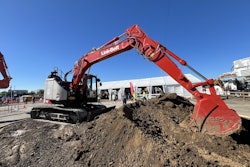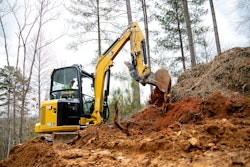While an increasing percentage of contractors in general have been using oil analysis programs during the past 10 years, around half or more of small to mid-sized companies are still shying away from the practice.
For some, there may be good reasons for this. A contractor who is operating older equipment, isn’t using premium oils and isn’t trying to extend drain intervals won’t see as many advantages from oil sampling as a contractor running new machines still under warranty, says Jim Morrison, lubricants technical advisor for Petro-Canada. The purpose of oil sampling is trend analysis, and trending is difficult with an old engine because you don’t know its status when you get it, he says.
Small contractors also have tight budgets, says Mark Minges, chief operating officer of POLARIS Labs, so if they don’t immediately see a cost benefit, they’re not going to do it. “And people tend to be afraid of numbers,” he says. “Oil analysis provides numbers. If you don’t know what the numbers mean, you’re not likely to get the benefits of it.”
On the other hand, oil sampling is a relatively inexpensive ($10 to $15 per sample) way to limit downtime by identifying and managing problems while they’re small rather than reacting to failures, says Bob Tyson, technical services manager for CHS, which makes Cenex-brand lubricants. Lowering overall operating costs and extending lubes are also possibilities.
The oil running through your equipment is your best predictive and preventive maintenance tool, says Tim Keane, Castrol project manager for BP. A sample of used oil tells you what is happening inside your machine and is key to maximizing your fleet’s efficiency, he continues.
“With a very simple procedure, you can tell a lot about what’s going on with a machine,” says Shawn Ewing, technical coordinator for commercial lubricants, ConocoPhillips.
If you are still grappling with this decision, you’ll have to weigh the pros and cons with your company’s unique characteristics in mind. “That’s the line I think a lot of contractors are walking,” Morrison says.
What’s new
As far as the process goes, nothing about oil analysis has changed over the past several years. But online reporting – which all major labs now offer – has reduced the time between mailing a sample and receiving results from 10 days to four. “There’s essentially no need for a paper copy anymore,” Ewing says. You can also chart and graph trends for a specific machine or an entire fleet online at no extra charge. “It’s a cost saver for everybody,” Ewing says. “The lab doesn’t have to send reports. It’s a win-win procedure.”
Sampling tips
But in order to get accurate results to work with, you have to extract a clean, representative sample from your machine. The following guidelines can help you do that.
Take the sample the same way and from the same place every time. If you change the variables, you risk affecting the results. “Consistency is the key,” Minges says.
The oil should be up to operating temperature when you take the sample. If you are using a suction pump or pulling a drain plug, take the sample before the oil has settled. Don’t shut down the machine and take a sample the next day.
Don’t take a sample when you’ve just added fresh oil. It changes the balance of the system.
Take a relative sample. Don’t pull oil from the bottom of the reservoir or from an area without a lot of oil flow. If you take the sample when you are changing the oil, let a significant amount of oil flow out before catching a sample. If you are using a suction gun, don’t push the tubing in so far that you pull oil off the bottom of the crank case. Debris settles at the bottom, so you won’t get a representative sample.
Use sampling bottles oil companies or laboratories provide. The probability of contaminating a sample is high if you don’t. Tyson says CHS’s lab sometimes gets samples in baby food jars and Ziploc bags. “We see samples come in in Coke bottles and ketchup containers,” Morrison says. “If you can think of a type of bottle, oil analysis labs have seen it.”
Keep oil analysis bottles clean. If possible, put them in a dry, sealed cabinet. “I’ve walked into places where these kits had a 1/2 inch of dust on them,” Ewing says. “That’s just asking for trouble. Use some common sense to get a good sample.” Also clean the area of the machine you will be taking the sample from.
Get the top on the sample bottle as soon as possible and mail the sample immediately. If you let it sit for a week the characteristics can change. And the faster you get results, the faster you can react.
Make sure you label the sample jar correctly – with the type of oil and the machine it came from. Provide all the information asked for in the oil analysis forms. The number of hours on the unit make a difference in deciding whether the oil is in good condition or not. Engine type and model number are important too. Labs sometimes get samples labeled only “diesel engine.”
Don’t bounce around between labs. Because of their different setups, you can get noticeably varying results from two labs even though both are doing things correctly.
Interpreting results
Laboratories and oil suppliers will train you or your employees if no one in your company knows how to take samples or interpret results. Morrison thinks one reason why some contractors don’t do oil analysis is because they have no one to translate the data. You get computer-generated comments with each sample, but even laboratory personnel are not satisfied with the computer analysis, Morrison says. If you don’t know how to interpret results, you can arrange to visit a lab or lube supplier or get them to tell you when they will be providing a course in your area. “Then it becomes well worth the money you’re spending,” Morrison says.
Trending is key when it comes to interpreting oil sample results, Ewing says. Don’t put too much weight on one sample. If you see high volumes of iron in a sample, it might be cause for alarm and it might not. You need to get on a regular schedule, whether it’s once a month, once a quarter or once a year.
Everything is relative to the specific type of machine as well. If you have the same engine in different machines, the oil analysis might be different, but it could still be right for each.
One common reason for doing oil analysis is to find out if you can extend drain intervals. But don’t make this decision based on a single sample either. Look at five or six. If the oil consistently looks good at 200 hours, you could try waiting until 225 or 250 hours, Tyson says.
Oil sampling does three things…
Sampling Methods
The best way to take samples – because it involves the least handling – is through pneumatic sampling valves, which are available for engine, transmission and hydraulic fluids. While manufacturers build them into some machines, the majority of sampling valves are installed as aftermarket devices and can be purchased from lube suppliers or labs. Installing a valve takes 25 to 30 minutes. Make sure you install check valves upstream of the filter. If you install them downstream, the samples will only tell you if the filter is working.
With a suction or “vampire” pump, you screw the sample bottle onto the pump and a long tube sucks oil from a fill tube or dipstick port into the container. You have to make sure the pumping apparatus is clean.
The least desirable sampling method is pulling the drain plug. It is difficult to get a representative sample using this technique, and the chances of contaminating the sample are high.
The following sources contributed to this article:
- Shawn Ewing, technical coordinator for commercial lubricants, ConocoPhillips
- Bob Tyson, technical services manager, CHS
- Jim Morrison, lubricants technical advisor, Petro-Canada
- Mark Minges, chief operating officer, POLARIS Labs
- Tim Keane, Castrol project manager for BP









